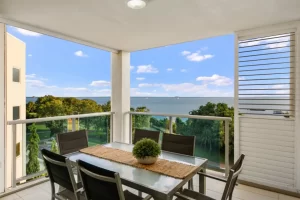Rapidly rising rents could push some aspiring homeowners to pull the trigger on buying a home, despite higher mortgage rates and inflated house prices, experts say.
Many home buyers had been priced out of the housing market as the widespread boom triggered a 27.8 per cent rise in median dwelling values nationwide since the pandemic. But renting has also become unaffordable, and in many cases even more so than buying.
In more than one in four markets across the capital cities, paying a mortgage on an average home is cheaper compared with paying rent, analysis by CoreLogic shows.
A total of 274 suburbs are more favourable for buyers than renters, including 201 unit markets and 73 house markets.
Across 20 unit markets and one house market in Sydney, buying is cheaper than renting; in Melbourne, 20 apartment markets favour buyers more than renters.
In western Sydney, buyers of median-priced units in Auburn are better off by $318 each month compared with renting, and they are ahead by $266 in Rosehill and by $254 in Mays Hill.
It is cheaper to pay a mortgage than rent in Sydney’s inner suburbs Roseberry and Mascot, where buyers can save $203 and $190 on average each month, respectively.
The monthly mortgage repayments for units in Melbourne’s inner-city suburbs Carlton and Docklands are cheaper than renting by $533 and $422, respectively. In Perth, buyers in Wembley and West Leederville are better off by $797 and $785, respectively.
Darwin is the most favourable market for buyers – the monthly mortgage repayments on a median-priced unit are cheaper by $1013 compared with renting.
In Canberra and Braddon, buyers are better off than renting by $810 and $753 each month respectively, and ahead by $801 in Spring Hill, in inner Brisbane.
The calculation took into account the current median values and median weekly rental valuation, assuming the latest average mortgage rate from the RBA for new owner-occupier variable loans of 2.49 per cent with a 20 per cent deposit over 30 years. No other fees or transaction costs were considered.
“It depends on the individual’s situation, but broadly speaking, it’s probably more challenging to rent, with rapidly rising rents in many parts of the country, increased competition for rents with holiday-makers and overseas arrivals,” said Eliza Owen, CoreLogic’s head of research.
“And although interest rates are rising, they are still pretty low, and in some markets prices are starting to fall.
“This could be a bit of a ‘sweet spot’ for first home buyers who have been saving up their deposit. You have a window of relatively low rates, slightly lower purchase prices in some parts of Sydney and Melbourne, and slowing market dynamics in terms of longer time on market.”
Sydney-based first-home buyer Reece Percy was among those who jumped the gun in the past few months.
“I was tired of renting and paying the landlord’s mortgage, so I decided to buy a one-bedroom apartment in the eastern suburbs,” he said.
“I looked over the long-term and realised I would be better off buying because I would be building my own asset base.
“I much rather spend my money paying for an asset that will grow in value over time. I plan to hold it over the long term because I believe time in the market beats timing the market.”
Taking the plunge
Jack Henderson, Sydney-based buyer’s agent with Henderson Advocacy, said the rising rents were a big factor motivating aspiring homeowners such as Mr Percy to take the plunge.
“Housing costs are going up whether you’re renting or looking to buy, but for those who have saved the deposit, soaring rents could potentially push them to take the plunge and buy their home,” he said.
“I think with rents continuing to rise, people may feel more comfortable spending that money on their own property than paying other people’s mortgage.
“Most people think paying $500 a week to rent is dead money, they’d much rather pay $600 or $700 a week to live in a property they own.”
Rents nationwide have jumped by 2.7 per cent in the three months ended April – faster than the 1.9 per cent gain for house prices, data from CoreLogic shows. Over the year, the median dwelling rent climbed 9 per cent.
“Rent rises probably do have a bit further to go,” Ms Owen said. “Upward pressure on rental values could persist amid higher wages growth, the return of overseas arrivals to Australia, and the lag at which rental supply responds to increases in demand.”
Although surging rents might eat into potential savings and make it harder to get over the deposit hurdle, the cooling property prices triggered by rising interest rates make it a much easier time to buy, said Nerida Conisbee, Ray White chief economist.
“Right now, we are seeing prices start to moderate as interest rates rise but conversely rents are rising rapidly,” she said.
“If you are someone who wants to flip houses quickly, now isn’t the time. But if you want to buy to hold long term, now is a good time to own or buy.”
This article is from Australian Financial Review, please click the following link for the original article: https://www.afr.com/property/residential/monthly-mortgage-cheaper-than-renting-in-274-suburbs-20220512-p5akmx




